Spotted wing drosophila
Updated March 13, 2023
Spotted wing drosophila (Drosophila suzukii), a serious pest of soft fruit and berries, was first identified in British Columbia in 2009. It is now widespread in Coastal and Interior fruit growing areas of B.C.
Spotted wing drosophila is native to Southeast Asia; preferring temperatures of 20-30 °C. It is known to infest thin-skinned fruit. Many species of fruit flies are present in late summer; most normally infest overripe, fallen, decaying fruit, so are not crop-limiting pests. However, a spotted wing drosophila female lays her eggs inside sound fruit before harvest with her saw-like ovipositor, which contaminates fruit with larvae, and causes it to become soft and unmarketable.
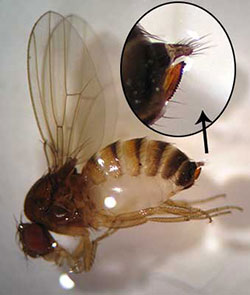 |
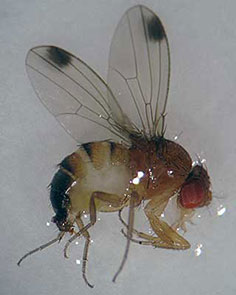 |
| Figure 1. Spotted wing drosophila adult female. Inset shows ovipositor. Photo Credit: Sheila Fitzpatrick, Agriculture & Agri-Food Canada, Pacific Agri-Food Research Centre, Agassiz |
Figure 2. Spotted wing drosophila adult male with wing spots Photo Credit: Sheila Fitzpatrick, Agriculture & Agri-Food Canada, Pacific Agri-Food Research Centre, Agassiz |
Appearance
Many features are typical for Drosophila flies, with a few key differences. Male and female characteristics are key identifiers for spotted wing drosophila.
Adults: 2-3 mm (1/8 inch) long, brownish with red eyes and clear fly-like wings. Compared to other fruit flies, D. suzukii is a robust fly, but this is difficult to discern unless compared directly to other species. Males have a black/grey spot on the end of each wing (figure 2), as well as two black ‘combs’ or bands on the front legs. The females do not have spots or leg bands. Females have saw-like ovipositors (egg-laying structure) that are used to cut into fruit skin (figure 1). Ovipositors are easier to see when extended. A hand-lens or dissecting microscope is needed to see the ovipositor.
Eggs: 0.6 mm long, oval, white, 2 filaments at one end (figure 3, 4).
Larvae: Legless, headless, up to 6 mm long at maturity, white or transparent (figure 5).
Pupa: 3 mm long, brown, football-shaped, two stalks with small finger-like projections on one end (figures 6 & 7).
Identification guide
Refer to the Identification Guide for Spotted Wing Drosophila for additional information on characteristics of this pest:
-
Identification Guide for Spotted Wing Drosophila (PDF, 2.5 MB)
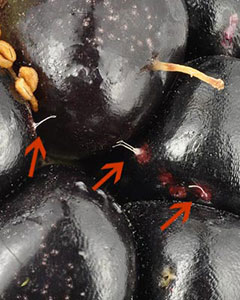 |
 |
| Figure 3. Spotted wing drosophila eggs in blackberry fruit Photo Credit: Dr. Ward Strong, Ministry of Forests, Lands and Natural Resource Operations, Kalamalka Forestry Centre, Vernon |
Figure 4. Spotted wing drosophila egg Photo Credit: Brigitte Rozema & Howard Thistlewood, Agriculture & Agri-Food Canada, Pacific Agri-Food Research Centre, Summerland |
 |
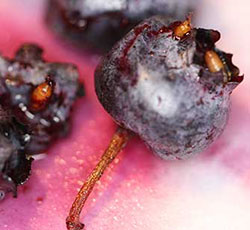 |
| Figure 5. Spotted wing drosophila larva in blueberry fruit | Figure 6. Spotted wing drosophila-infested blueberry fruit with pupae |
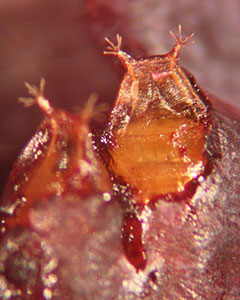 |
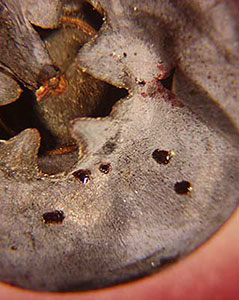 |
| Figure 7. Spotted wing drosophila pupae | Figure 8. Spotted wing drosophila damage in blueberry |
Distribution
Spotted wing drosophila is widely distributed globally in most temperate soft fruit producing areas, including North and South America, Europe, and Asia. Notable exceptions are New Zealand and Australia, where it is not known to be established.
Hosts
In British Columbia, spotted wing drosophila has been confirmed infesting wild and cultivated raspberry and blackberry, blueberry, strawberry, cherry, peach, nectarine, apricot, plum, and suspected in hardy kiwifruit. Wild hosts confirmed in Coastal B.C. include Oregon grape (Mahonia aquafolium), red elderberry (Sambucus racemosa), currant (Ribes), dogwood (Cornus kousa), mulberry (Morus), salmonberry (Rubus spectabilis), thimbleberry (Rubus parviflorus), salal (Gaultheria shallon), Indian plum, Osoberry (Oemleria cerasiformis), wild Prunus species, and red huckleberry (Vaccinium parvifolium). In Interior B.C, wild hosts confirmed include Oregon grape (Mahonia sp.), blue elderberry (Sambucus cerulean), Northern black currant (Ribes hudsonianum), Tatarian honeysuckle (Lonicera tatarica), Mahaleb cherry (Prunus mahaleb), and golden currant (Ribes aureum) (H. Thistlewood, AAFC, Summerland).
Damage
Females lay eggs under the skin of ripe fruit shortly before harvest. Larvae hatch and begin to feed within the fruit, causing softening in the area of feeding. There can be several larvae in a fruit, which hastens softening and fruit collapse. Holes the size of pin pricks are evident within the soft areas of infested fruit (figure 3). These holes result from egg laying and are used as breathing holes by larvae. In addition, these holes provide entry points for diseases such as brown rot and botrytis.
Life cycle
Spotted wing drosophila emerging in the fall overwinter as adult flies. In spring flies become active, mate and lay eggs in ripening fruit. Based on climate model predictions, there could be up to 5 generations per year in B.C. Generations will likely be overlapping as flies are relatively long-lived particularly at temperatures of 20°C and cooler. Based on a Japanese publication (Kanzawa 1939), oviposition lasts 10-59 days, with 7-16 eggs laid per day, and averaging 384 eggs per female. Eggs hatch in 2-72 hours, larvae mature in 3-13 days, and pupae reside in fruit or outside of fruit for 3-15 days. In the lab at constant temperature, one generation takes 50 days at 12°C, 21-25 days at 15°C, 19 days at 18°C, 8.5 days at 25°C, and 7 days at 28°C. Adults are also attracted to dropped and decaying fruit and will feed on it. Spotted wing drosophila will complete its development in dropped fruit.
How it spreads
Spotted wing drosophila adults can be blown by wind to nearby locations. However, long distance dispersal is through transportation of infested fruit to new regions. Non-fruit bearing plants are not considered to be of significant risk to transport this pest.
Management
Management recommendations include registered insecticides, good harvest and sanitation practices, such as picking fruit on time, culling soft fruit, destroying culls, and keeping processing areas and equipment free of old fruit.
For more details on managing this pest in berry and tree fruit crops:
Quarantine regulations
This pest is not regulated in the United States and Canada. The regulatory status of this fly in other countries should be checked with packers.
Surveillance
Area-wide surveillance with apple cider vinegar traps in British Columbia for spotted wing drosophila indicates that flies are present and active throughout the year in the Fraser Valley, though numbers are very low in February through May. In the fruit growing interior regions, spotted wing drosophila can be caught in traps from May until November.
Adults: Spotted wing drosophila flies can be monitored with apple cider vinegar baited cup-traps. Other commercial baits and trap types are available for monitoring the fly. Adult flies are needed to confirm species. Baited traps are useful for determining when the flies become active in the spring and summer around and inside fields.
Larvae: Suspect fruit can be collected and inspected for larvae. Larvae can be monitored for in harvested fruit by use of the ‘fruit dunk’ method. Collect at least 20 fruit to be put into a salt or sugar solution in a baggie or light coloured container, stirred, and fruit gently squished to extract and float out the larvae. In most berry crops, no other species of fly larvae infest ripe fruit, however in cherries, Rhagoletis sp. larvae may be present. The ‘fruit dunk’ is useful for checking fruit for infestation during harvest, either at the field or at the packers, and can help locate areas of concern in a field.
Beneficial insects
Predators: A few predators feed on spotted wing drosophila, though the impact these have on populations in fields is hard to measure. Examples include Orius and Rove beetles, which are naturally occurring in fields and wild areas.
Parasitoids: Two tiny wasps originally from Asia (where spotted wing drosophila is also from) are now established in coastal British Columbia. First detection of Leptopilina japonica in Coastal B.C. was in 2016 in late season strawberries, and both L. japonica and Ganaspis brasiliensis were found to be widely distributed in the Fraser Valley in 2020. Both parasitoids are present on southern Vancouver Island. The parasitoids are not yet known to be present in Interior British Columbia. The two parasitoids attack larvae inside fruit. Most parasitism is found in wild hosts, however, some parasitism is detected in commercial berry fields.
Related links
AgriService BC
Have a question? Call or email us.
Telephone: 1 888 221-7141
E-mail: AgriServiceBC@gov.bc.ca
